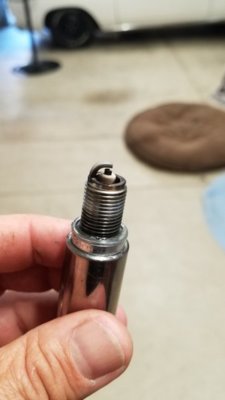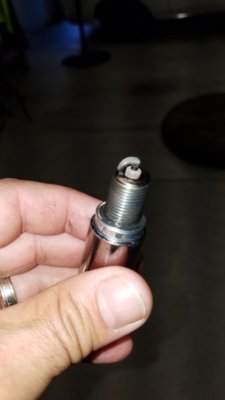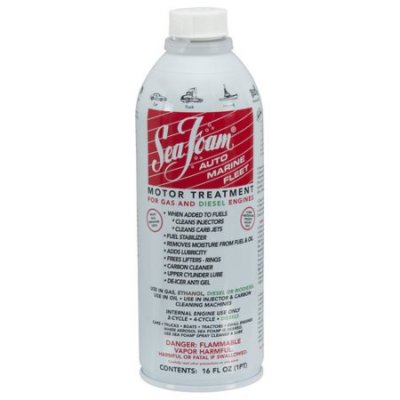Wasn't expecting any change in performance or anything like that, I just wanted to run it through my engine(low-mile 440)because I had leakage under the valley pan awhile back that filled my chambers with some oil. So, I followed their instructions and ran a can through the vacuum port on my carb, drove it, and afterwards upon checking my carb tune I noticed that my idle vacuum in drive went from 13-14 to 15-16... so it definitely did the engine good
You are using an out of date browser. It may not display this or other websites correctly.
You should upgrade or use an alternative browser.
You should upgrade or use an alternative browser.
Sea-foam results
- Thread starter beanhead
- Start date
PurpleBeeper
Well-Known Member
Seafoam was developed in the late 1930's I believe & originally sold around 1945 (?). I know the formula and it is beautiful in its simplicity and function. The stuff really does 95% of what it claims. I've used it very successfully to de-carbonize my cylinders too.
1967coronet440
Well-Known Member
I use it also. My brother in law runs it in everything. Daily drivers, RV, riding mowers, weed eater, chainsaw, power washer. Speaking of the power washer, it’s a 20 year old craftsman that hasn’t been used in some time. Filled it with some sea foam, topped off gas, a couple light pulls on choke, good pull on run and fired right up. I recommend it for everything
what is this mystery product i'm not aware of? any picture of a can?
Cool yeah I wish I would have used it sooner LOL... for the vacuum to increase do you guys concur that the valves must be sealing just a tiny bit better?
Ranger16
Well-Known Member
Sea-Foam =
40-60% pale oil
25-35% Naptha
10-20% IPA (Isopropyl alcohol)
I consider it snake oil.
My cylinders were so badly carboned when I got it that I had to let the clutch out in gear to prevent it from dieseling for ever when I shut down. One treatment and it simply shuts down like it should when I turn off the ignition. No need for all that plug fouling crap in SeaFoam. It DOES do a good job in mosquito abatement though.
40-60% pale oil
25-35% Naptha
10-20% IPA (Isopropyl alcohol)
I consider it snake oil.
You can decarbonize your cylinders with water. Just connect a vacuum hose to the vacuum port on your carb, run the RPM's up to about 2000 (hot engine only) and stick the hose in a glass of water until it sucks it dry.I've used it very successfully to de-carbonize my cylinders too.
My cylinders were so badly carboned when I got it that I had to let the clutch out in gear to prevent it from dieseling for ever when I shut down. One treatment and it simply shuts down like it should when I turn off the ignition. No need for all that plug fouling crap in SeaFoam. It DOES do a good job in mosquito abatement though.
1967coronet440
Well-Known Member
Ha yeah... well I definitely wasn't buying any claims of it improving power or restoring throttle response etc etc...but if it was just snake oil it wouldn't do jacksquat. Thanks for the tip on the water though, that's free and something I can easily try...Sea-Foam =
40-60% pale oil
25-35% Naptha
10-20% IPA (Isopropyl alcohol)
I consider it snake oil.
You can decarbonize your cylinders with water. Just connect a vacuum hose to the vacuum port on your carb, run the RPM's up to about 2000 (hot engine only) and stick the hose in a glass of water until it sucks it dry.
My cylinders were so badly carboned when I got it that I had to let the clutch out in gear to prevent it from dieseling for ever when I shut down. One treatment and it simply shuts down like it should when I turn off the ignition. No need for all that plug fouling crap in SeaFoam. It DOES do a good job in mosquito abatement though.
As far as it fouling plugs... That thought absolutely crossed my mind. Pulled a couple to check and it looks like we're all good there, thank goodness


- Local time
- 5:12 AM
- Joined
- May 14, 2011
- Messages
- 17,242
- Reaction score
- 32,432
- Location
- On the Ridge, TN
Y'all that are using it - do you do what I've seen the kids do with their rides, where they basically feed it as fast as they can through a running engine through a vacuum line (usually the brake booster line), then immediately shut the engine down for a bit?
I think they do it just for the smoke show afterwards, but heck, what do I know?
I think they do it just for the smoke show afterwards, but heck, what do I know?
BeeKool
Well-Known Member
I buy it by the gallon.
Use it quite a bit.
I have an old Johnson outboard on my father's pontoon that won't even idle w/o sea-foam.
I mainly just use it as a fuel additive, but upon reading this I use it in Vaccumn lines of a few vehicles.
Use it quite a bit.
I have an old Johnson outboard on my father's pontoon that won't even idle w/o sea-foam.
I mainly just use it as a fuel additive, but upon reading this I use it in Vaccumn lines of a few vehicles.
Daves69
Well-Known Member
After I got it I found the throttle body on my 5.7 Ram was caked with goo from crankcase blow-by. Poured some on a rag and cleaned up the bore and plate without pulling the body off. I do use a can in my tank once a year or throw one in on trips with the boat.
For the boat engine, I use Stabil in all the gas I've ever put in it. Same for all my lawn stuff.

For the boat engine, I use Stabil in all the gas I've ever put in it. Same for all my lawn stuff.
Lol, my '95. Slight pump leak but still kickin' (Available if ya' need a spare, cheap BTW) ....…..............Speaking of the power washer, it’s a 20 year old craftsman...….
wagonman
Well-Known Member
- Local time
- 4:12 AM
- Joined
- Aug 1, 2015
- Messages
- 2,100
- Reaction score
- 1,762
- Location
- Deming New Mexico
Back in the day We used Gm Top Engine cleaner on every tune-up. Run the engine up to temp, use the pour in or spray can till the engine stalled. Let it soak in and changed the plugs,points ect. Talk about a smoke show, good for killing mosquitos, small critters and Ex-wives. Now outlawed in Cali of course and no longer available. Good stuff,have used Seafoam with similar results. I have 2 cans of the GM stuff hoarded in case I get married again.
PurpleBeeper
Well-Known Member
Sea-Foam =
40-60% pale oil
25-35% Naptha
10-20% IPA (Isopropyl alcohol)
I consider it snake oil.
You can decarbonize your cylinders with water. Just connect a vacuum hose to the vacuum port on your carb, run the RPM's up to about 2000 (hot engine only) and stick the hose in a glass of water until it sucks it dry.
My cylinders were so badly carboned when I got it that I had to let the clutch out in gear to prevent it from dieseling for ever when I shut down. One treatment and it simply shuts down like it should when I turn off the ignition. No need for all that plug fouling crap in SeaFoam. It DOES do a good job in mosquito abatement though.
Ahhh, yes, I saw that same internet posting about the formula, and trust me, it took me 6 months with some pretty sophisticated laboratory equipment to analyze Seafoam & that is NOT the formula. What you listed is about 1/2 correct, but not the same. Once you fully understand what's in it, it makes complete sense.
I was a skeptic myself, though my step-father recommended it highly. My decarbonizing test made me a believer, at least for that use. I have also used water poured down the carburetor to clean valves (might have worked on the cylinders too, but I didn't consider that). We now all have access to boroscopes for about $25 that plug into your laptop or cell phone. Really, the only way to know for sure is to look inside a spark plug hole before & after treatment with whatever product. There is a guy on u-tube called "Chris Fix" who does a lot of this testing....check him out sometime. He's not paid by anybody.
SublimeSixpack
Well-Known Member
I believe SeaFoam Motor Treatment to be a good product. Have been using it for 4 or 5 years now with good results in cars, trucks, motorcycles, and small engines (mowers, trimmers, etc.).
I did it after driving so the engine would be hot...set the idle to about 1500, stuck the straw in the full vacuum port on the carb base, and held the spray button down...took about 5 minutes to suck it all in. Ya it smoked, not quite as bad as some of the videos I've seen but just in case I did it at my shop to be nice to my neighbors. When it was done I reset the idle, shut it down for a few then drove it...no smoke after I shut it off, just during the processY'all that are using it - do you do what I've seen the kids do with their rides, where they basically feed it as fast as they can through a running engine through a vacuum line (usually the brake booster line), then immediately shut the engine down for a bit?
I think they do it just for the smoke show afterwards, but heck, what do I know?
Ranger16
Well-Known Member
Hey beeper, for what it's worth, I got that formula right off of SeaFoam's own data sheet.Ahhh, yes, I saw that same internet posting about the formula, and trust me, it took me 6 months with some pretty sophisticated laboratory equipment to analyze Seafoam & that is NOT the formula. What you listed is about 1/2 correct, but not the same. Once you fully understand what's in it, it makes complete sense.

- Local time
- 2:12 AM
- Joined
- Mar 14, 2012
- Messages
- 17,044
- Reaction score
- 28,499
- Location
- Surrey, B.C. Canada
Maybe they've changed their data sheets. The one I have is pretty vague.

PurpleBeeper
Well-Known Member
Actually, a safety data sheet is not the formula. By law, you have to report anything hazardous over 1% and anything that causes cancer above 0.1%. Anything non-hazardous (e.g. water) doesn't have to be listed. You can also list things as "trade secret" and only provide it to medical personnel (e.g. some idiot drinks it & is in the hospital). You can also list things as "blends" such as what photon shows, which do not require specific information to be listed. "Hydrocarbon cuts" like solvents, oils, waxes, gasoline, etc. are most often mixtures of tens or hundreds of chemicals, so no specific CAS number has to be listed, and even then, specific CAS numbers aren't "specific" with hydrocarbons, polymers (e.g. plastics) and some other groups of chemicals....whew, that's a mouthful.Hey beeper, for what it's worth, I got that formula right off of SeaFoam's own data sheet.
Now Seafoam does have some isopropanol (aka rubbing alcohol) which allows it to act as a "fuel antifreeze" like Heet, and it is otherwise a blend of hydrocarbons....the exact blend being their "trade secret juice"
Similar threads
- Replies
- 33
- Views
- 3K
- Replies
- 33
- Views
- 3K

















